IN THIS ISSUE
- Why so few right whales?
- Zebra hunting in Georgia
- Alapaha WMA: storied site, sandhills
 Right whale #1012 with calf (Sea to Shore Alliance, NOAA permit 15488)
Already endangered, North Atlantic right whales face an even more uncertain future following the Southeast’s second-worst calving season since surveys began in the 1980s.
Researchers with Georgia DNR, the Florida Fish and Wildlife Conservation Commission, NOAA and Sea to Shore Alliance saw only seven right whales this winter off Georgia, north Florida and South Carolina, traditionally calving central for this species that literally grows as big as a bus. Only three of those whales were calves (a fourth calf was seen in Cape Cod Bay this month).
Clay George, DNR’s lead right whale scientist, said the average number of calves reported in the region has dropped by half, from 24 calves annually 2001-2011 to 12 a year since 2012. This winter also registered a new low for the total number of right whales seen in the region. Season totals topped 100 per year in the mid-2000s.
“Is this just the low point in a natural cycle, or are low calving numbers the new normal?” George said. “We just don’t know. All we can do is wait and see.”
Read more about this trend, and hopes for a reversal.
Back to top.
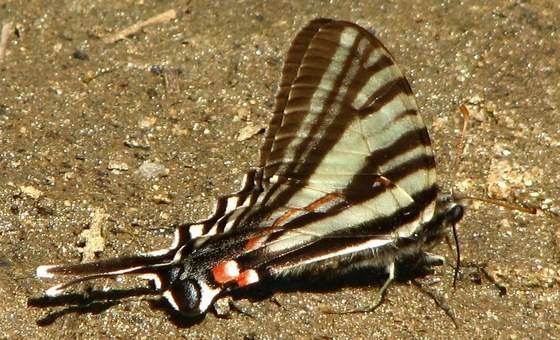 Zebra swallowtail (Terry W. Johnson)
By TERRY W. JOHNSON
Each year on a warm afternoon in mid-March I surrender to the urge to find my first zebra of the year in Georgia. Zebra swallowtail, that is.
From experience, I have learned that the best chance of seeing these eye-catching butterflies is in open, hardwood forests. And in March into early April, these woodlands are usually leafless, allowing the bright spring sunshine to reach the forest floor, unfiltered by a myriad of green leaves.
While this description probably doesn’t fit what you think of as the ideal place to find butterflies, for zebra swallowtails, the habitat is just right. …
Read Terry’s column to learn where to search for these flying zebras.
Terry W. Johnson is a retired DNR nongame program manager and executive director of TERN, Nongame Conservation’s friends group. Read more in the Out My Backdoor library, Terry's Backyard Wildlife Connection blog and his new book, “A Journey of Discovery: Monroe County Outdoors.”
P.S.: Here’s a tip on taking close-up photos of butterflies and flowers.
Coming up: Terry is giving a presentation at the Spring Gardening Symposium May 5 at the Plains (Ga.) Community Center. The workshop is held by The Garden Club of Georgia’s Plains Chautauqua Magnolia District and the Rosalynn Carter Butterfly Trail. Register online. Details: plainsed@gmail.com, (229) 824-4567.
Back to top.
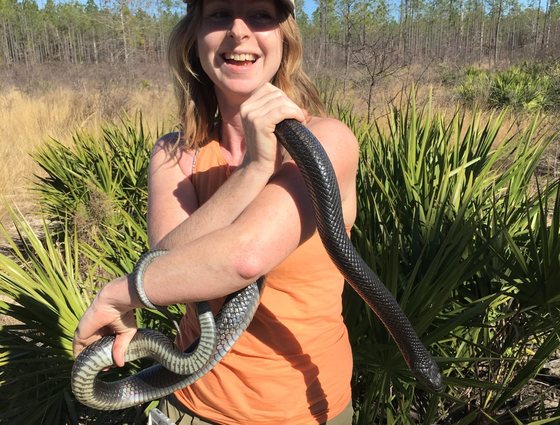 UGA graduate student Erin Cork with indigo snake (John Jensen/DNR)
By MATT ELLIOTT
Alapaha River Wildlife Management Area had achieved near-legendary status in some circles well before the 6,869 acres were opened as a WMA on Sept. 30.
The site has been variously known as the Lentile Tract, the Snake Sanctuary, Dan Speake’s indigo snake study site (by herpetologists familiar with the work of the Auburn University wildlife professor emeritus) and the Pasture (by local hunters).
Providing the border along Irwin and Tift counties between Tifton and Ocilla, the Alapaha River at this point is more a series of lakes connected by vast floodplain forests than a constant flowing stream. During the Wisconsinan glaciation of the Pleistocene epoch, about 20,000 to 25,000 years ago, cold westerly winds blew across what was then a dry riverbed, piling up massive amounts of quartz sand on the lee side.
These sandhills dominate the current landscape at Alapaha River WMA, and provided the basis for the state’s interest in seeing this property permanently conserved. ...
Explore the wildlife and habitats of Alapaha River WMA in this blog post.
Matt Elliott is assistant chief of the Nongame Conservation Section
in DNR’s Wildlife Resources Division. This article originally ran in The
Longleaf Leader, quarterly magazine of The Longleaf Alliance.
Back to top.
WHAT YOU CAN DO: GIFT FOR WILDLIFE
How can you help conserve rare Georgia wildlife and wild places like Alapaha River WMA now and for future generations? One way is through an estate, memorial or other gift to the Georgia Nongame Wildlife Conservation Fund.
The Nongame Wildlife Conservation Fund is dedicated by state law to support conservation of rare and other native wildlife that aren’t legally hunted, fished for or collected, plus rare native plants and the habitats these species need.
In 2016, the fund received $3,416 in gifts to help preserve wildlife. For details on how to contribute, call the Nongame Conservation Section at (770) 761-3035.
Back to top.
Gov. Nathan Deal signed House Bill 208 Tuesday at DNR Coastal Regional Headquarters in Brunswick. Effective July 1, the changes will simplify Georgia's hunting and fishing license structure and adjust fees for resident hunting and fishing licenses for the first time since 1992, ranking Georgia in the middle of other Southeastern states for resident license fees. Support for the changes was strong. With the additional revenue, DNR will improve wildlife and fish habitat and management on public and private lands and waters; create more shooting ranges; improve boating access; add youth education opportunities; increase fish stocking; and, add approximately 40 conservation rangers.
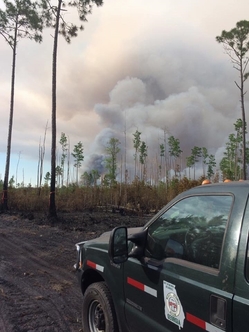 The West Mims wildfire at Okefenokee National Wildlife Refuge grew to more than 60,000 acres this week.
Fire and support crews of nearly 500 people, including DNR
Wildlife Resources Division staff, are working to contain the blaze
started by lightning April 6 on the swamp’s southwest side. Wildfire overview. Southern Fire Exchange fact sheet: Prescribed fire and wildfire risk reduction.
A helicopter survey
of nesting Florida sandhill cranes at
Okefenokee NWR documented 11 active or recently active crane nests
before remaining flights were cancelled by the wildfire. DNR survey
leader Todd Schneider said a reconnaissance flight also marked a
promising area not surveyed before.
Reticulated flatwoods salamanders are on a run, figuratively, at
Mayhaw Wildlife Management Area. A larva caught in March by
DNR wildlife biologist Thomas Floyd confirmed a second straight year of
reproduction at the southwest Georgia WMA. The endangered sallies were re-discovered at Mayhaw in 2015, the first time the species had been documented in Georgia in more than a decade (“Rare salamanders," March 31, 2015).
Sampling for sicklefin redhorse by fyke nets in Brasstown Creek,
Georgia’s only known population of the rare suckers, helped DNR and
partners catch, PIT-tag and release 95 sicklefins, 12 of them tagged
before. High flows complicated netting in the Nottely River
aimed at confirming there are no sicklefin redhorse in that waterway,
key to possibly restoring the species upstream of Lake Nottely.
Back to top.
|
 DNR’s John Thrift and East Georgia State College's Alicia Winfrey at Ohoopee Dunes (EGSC)
East Georgia State College biology students and Swainsboro Middle School Sci-Fries Club members helped DNR staff plant endangered pond spice and pondberry at Ohoopee Dunes Wildlife Management Area in March. The project also benefited from other Georgia Plant Conservation Alliance members such as Chattahoochee Nature Center and Beech Hollow Farms. Photos.
Nesting season is on for Georgia’s beach-nesting birds, and DNR
is encouraging beach-goers to steer clear of areas these birds and fellow
migrants need to nest and forage. Tips on sharing the beach.
Georgia’s fourth annual Bat Blitz will help researchers collect
data on bats in and around Vogel State Park in northeast Georgia May
11-14. Organized by the Georgia Bat Working Group, the blitz also
features a mist-netting demonstration and other "batty” activities for the public on May 12.
 Flint River trash clean-up crew at Sprewell Bluff WMA (Hal Massie/DNR)
Volunteers filled about 50 bags with trash and hauled away tires and other large junk items during an April 15 cleanup organized by Flint Riverkeeper and DNR at Sprewell Bluff Wildlife Management Area near Thomaston.
Georgia coast boaters should be on the lookout for sea turtles and manatees. Boat strikes are a leading cause of injuries and deaths for these protected animals. Boaters who hit one are urged to immediately call DNR at 800-2-SAVE-ME (800-272-8363).
Raccoons, deer and other animals are often labeled a nuisance when they develop intrusive and destructive habits in suburban settings. But homeowners can play a role in keeping wildlife from becoming a nuisance by limiting easy access to food. Here's how.
#FridaysontheFarm offers weekly stories of farmers, producers and landowners
who are helped by the USDA Natural Resources Conservation Service and
others partners to “help the land.” Included: Front Field Farm, a Georgia organic farm engineered with water-saving irrigation.
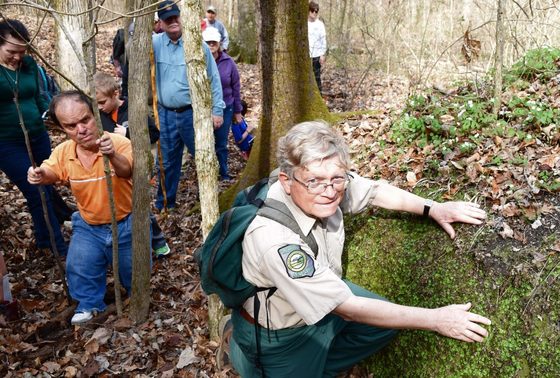 Tom Patrick leads Oaky Woods hike (John Trussell)
Botanist Tom Patrick (above) of the Nongame Conservation Section explained rare plants and habitats such as Blackland, or chalk, prairies, during a February hike with about 50 people at Oaky Woods Wildlife Management Area near Kathleen. Patrick discusses chalk prairies in this video.
Names in the news: Former Georgia Gov. Sonny Perdue said after being sworn in as U.S. agriculture secretary Tuesday that the only legacy he seeks is the one "that any grandparent or parent seeks – to be good stewards, and to hand off our nation, our home, our fields, our forests and our farms to the next generation in better shape than we found it.” His USDA Twitter handle is @SecretarySonny. Writer and veterinarian Dr. Abbie Gascho Landis, wife of former DNR mussel scientist Andrew Gascho Landis, has written “Immersion: The Science and Mystery of Freshwater Mussels” (Island Press). Two-time Pulitzer Prize winner E.O. Wilson called the book “nature writing at its best.” Dr. Lindsay Boring is retiring as director of the Joseph W. Jones Ecological Research Center at Ichauway July 4. His successor: Dr. Kier Klepzig, currently assistant director at the U.S. Forest Service's Southern Research Station in Asheville, N.C. Georgia Adopt-A-Stream has named Kevin Smith, a Keep Forsyth County Beautiful outreach specialist, 2016 Trainer of the Year.
COMING UP
April 28-29 – Native Plant Botanical Garden plant sales, 10 a.m.-2 p.m., Georgia Perimeter College, Decatur. Also: May 5-6, 12, 19-20, 26-27.
April 29-30 – DNR Youth Birding Competition (awards banquet 5 p.m., Charlie Elliott Wildlife Center, Mansfield)
May 11 – Montane longleaf pine meeting for area landowners (ecosystem, fire management and planting opportunities), 6:30-8:30 p.m., Paulding Meadows Park, Dallas. Organized by Paulding County UGA Extension Office and The Nature Conservancy. Pre-registration required: 770.443.7616 or uge2223@uga.edu.
May 12 – Foothills Landscape Project field trip (focus: Watergauge Forest Health & Wildlife Habitat Improvement Project on Chattahoochee National Forest Chattooga River Ranger District), 9 a.m.-1 p.m., Lakemont. Registration: Angie Bell, FoothillsLandscape@fs.fed.us, (770) 297-3095.
May 13 – Bird banding, 5:20 a.m., at Panola Mountain State Park, Stockbridge. Also: 5:15 a.m. May 28. June-August dates in upcoming issues. Contact Charlie Muise, Georgia Important Bird Areas Program.
May 13 – TERN membership meeting, 1-3 p.m., Charlie Elliott Wildlife Center, Mansfield
May 20 – J.A.K.E.S. Day, 10 a.m.-2 p.m., Charlie Elliott Wildlife Center, Mansfield
June 3-8 – Camp TALON (Teen Adventures in Learning Ornithology and Nature), St. Simons Island. Register by May 5.
July 7-9 – Beyond Becoming an Outdoor-woman (BOW) handgun preparedness course, Charlie Elliott Wildlife Center, Mansfield. Also: July 21-24, Coastal BOW, Sapelo Island; Sept. 8-10, advanced handgun workshop, Charlie Elliott; Nov. 3-5, annual BOW workshop, Charlie Elliott.
WHAT YOU MISSED
... in the last Georgia Wild:
– Defense Department strategy is good news for gophers.
– Finessing fire to restore habitat at Big Dukes Pond WMA.
– Decatur kindergarteners raise money for rare species.
Back to top.
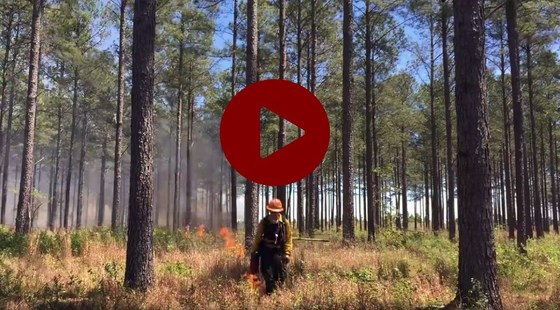 – Time-lapse of an April 10 prescribed burn on Fall Line Sandhills Wildlife Management Area by DNR’s west-central Georgia fire crew. Senior wildlife biologist Nathan Klaus videoed the burn.
– "Expert: Of 42 snake species in Georgia, only six are venomous," WGXA-TV (Fox 24, ABC 16, Macon)
– "Walker County marks wildlife day," WDEF-TV (Channel 12, Chattanooga, TN) (In a wildlife license plates contest sponsored by The Environmental Resources Network, Walker finished second in renewals and third in sales. Details in the previous Georgia Wild.)
– “Springtime in the duck pond,” Jerry Turner, Thomas County
– “Python hunters capture 15-foot snake in Florida Everglades,” Fox News
– “Scientists have finally found a live giant shipworm,” Science Alert
– Juvenile mountain lion calling, Jason Craig
– “New pika behavior reveals adaptation to human presence,” Oregon Zoo
(Confession: The pika video is a holdover from April Fool’s. We couldn't resist.)
Back to top.
"Right whales suffer bleak calving season off Georgia coast," Savannah Morning News. Also: "Endangered right whales deliver fewest births in 17 years," San Francisco Chronicle and others via AP
"Wildlife day comes to Walker County," Walker County Messenger. Also: Chattanoogan.com
"DNR hosts wildlife tag day in Canton," Canton Patch
"State urges boaters to slow down" for manatees, sea turtles, Bryan County News
"Whales, shorebirds dinner conversation at SSI event," The (Brunswick) News
"Protecting military readiness and the iconic gopher tortoise," U.S. Fish and Wildlife Service
"Coyotes don't belong in Georgia," The Northeast Georgian
"Forest sale revived by lawmakers, environmentalist," The (Gainesville) Times
"DNR: Dry weather to blame for more alligator sightings," WALB-TV (Channel 10, Albany)
"Unraveling the mysteries of migrating semipalmated sandpipers," Audubon
"7 years after Deepwater Horizon oil spill, Louisiana dolphins struggle to reproduce," ABC News
Back to top.
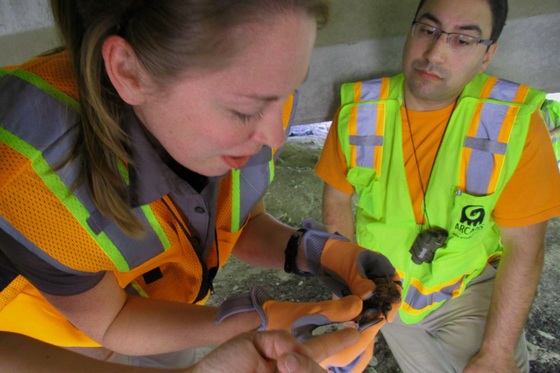
Big brown bat in hand,
Nongame Conservation Section wildlife biologist Laci Coleman discusses
inspecting bridges and culverts for bats with Danny Figueroa of Arcadis US Inc.
during training for environmental consultants. Coleman, senior biologist
Katrina Morris and technician Leanne Burns led the April 11 session, teaming
with state Department of Transportation ecologists. In Georgia, bridges and
culverts offer refuge for bats year-round. DOT procedures
include determining whether bats or other protected wildlife are using the structures when they are part of road projects.
More training for consultants, who do much of the ecological legwork, is set
for May 4. (Also see “Bat rescue under a
bridge,” Feb. 13, 2016.)
Masthead image: pine snake (Beth Schlimm). Coastal Plain populations of this species are associated with xeric habitats with deep sandy soils, such as those found at Alapaha River WMA.
In Noteworthy: DNR engine "Ember" at the Okefenokee (Bryn Pipes/DNR)
Back to top.
|